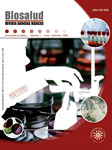Authors
Abstract
There are several activities that represent biological occupational risk for the transmission and spread of zoonotic diseases such as leptospirosis, brucellosis, toxoplasmosis, which include the slaughter of animals for human consumption. The aim of the present study was to establish the seroprevalence of the Brucella abortus, Leptospira spp. and Toxoplasma gondii infection in 221 slaughterhouse workers from 22 municipalities in the department of Tolima (Colombia), as well as identifying the serovars of Leptospira. The prevalence of anti-Leptospira antibodies was detected in 17.6% (39/221) of the workers by the FC technique, 1% (2/221) for anti-Brucella antibodies by microagglutination lisis, and 83% (183/221) for anti-Toxoplasma antibodies by ELISA. The more frequent Leptospira serovars were L. icterohaemorrhagiae, L. bratislava and L. hardjo. There is evidence that the zoonoses evaluated are present in the population working in slaughterhouses in the department of Tolima; therefore,it is necessary to strengthen promotion, prevention and control policies of zoonotic diseases in high-risk population.
References
Cediel N, Villamil LC. Riesgo biológico ocupacional en la Medicina Veterinaria, área de intervención prioritaria. Rev. Salud pública 2004;6(1):28-43.
Drudi D. Are animals occupational hazards? Compensation and working conditions 2000;5(3):15-22.
Bharti AR, Nally JE, Ricaldi JN, Matthias MA, Díaz M, Lovett MA et al. Leptospirosis: a zoonotic disease of global importance. Lancet Infect Dis. 2003;(3):757-771.
Castaño P. Estudio y análisis del riesgo biológico ocupacional en Colombia. Informe técnico, Ministerio de Trabajo y Seguridad Social; 1997; p. 9-80.
Batelli G, Baldelli R, Ghinzelli M, Mantovani A. Occupational zoonoses in animal husbandry and related activities. Ann. Ist. Super Sanitá, 2006; 49(4):391-396.
Carneiro M, Giacomini L, Costa M. Leptospirosis asociada a la exposición ocupacional: Estudio clínico y epidemiológico. Rev Chil Infect 2004;21(4):339-344.
Reid A. Brucellosis - A persistent occupational hazard in Ireland. Int J Occup Environ Health 2005;11:302-304.
Morales DF, Combariza DA. Seroprevalencia de brucelosis en trabajadores de mataderos de municipios del Tolima (Colombia). Rev Cienc Salud 2003;2:15-23.
Ross DJ, Cherry NM, Mc Donald J.C. Occupationally acquired infectious disease in the United Kingdom, 1996 to 1997. Commun Dis Public Health, 1998;1:98-102.
Levett P. Leptospirosis. Clin Microbiol Rev. 2001;14(2):296-326.
Klun I, Djurkovic O, Katic S, Nikolic A. Cross-sectional survey on Toxoplasma gondii infection in cattle, sheep and pigs in Serbia: Seroprevalence and risk factors. Vet Parasitol 2006;135:121-131.
López C, Díaz J, Gómez J. Factores de riesgo en mujeres embarazadas, infectadas por Toxoplasma gonddii en Armenia Colombia. Rev Salud Pública. 2005;7(2):180-190.
Nájera S, Alvis N, Babilonia D, Álvarez L, Máttar S. Leptospirosis ocupacional en una región del Caribe colombiano. Salud Pública Mex 2004;47(3):240-244.
Rodríguez G. Estado actual de la leptospirosis. MVZ Córdoba 2000;5(1):65-63.
Ochoa J, Sánchez A, Ruiz I. Epidemiología de la leptospirosis en una zona andina de producción pecuaria. Rev Panam Salud Pública 2000;7(5):325-331.
Orrego A, Giraldo G, Ríos B, Valencia P. Leptospirosis en personas de riesgo de quince explotaciones porcinas y de la Central de Sacrificio de Manizales, Colombia. Arch. Med. Vet. 2003;35(2):205-213.
Levett P. Leptospirosis: A forgotten zoonosis? Clin Immunol Reviews 2004;4(6):435-448.
Rocha T, Ellis WA, Montgomery J, Gilmore C, Regalla J, Brem S. Microbiological and serological study of leptospirosis in horses at slaughter: first isolations. Res Vet Sci 2004;76:199-202.
Organización Panamericana de la Salud - Centro Panamericano de Fiebre Aftosa. Brucelosis y Tuberculosis (M. bovis) - Situación de los Programas en las Américas. Publicación No. 1 PANAFTOSA. 2000; p. 46.
Dubey JP. Toxoplasmosis - a waterborne zoonosis. Vet Parasitol 2004;126:57-72.
Gallego C, Saavedra C, Gómez-Marín JE. Direct genotyping of animal and human isolates of Toxoplasma gondii from Colombia (South America). Acta Trop 2006;97:161-167.
Petersen E, Pollak A, Reiter-Owona I. Recent trends in research on congenital toxoplasmosis. Int J Parasitol 2001;31:115-44.
Aspinall TV, Marlee D, Hyde JE, Sims P. Prevalence of Toxoplasma gondii in commercial meat products as monitored by polymerase chain reaction - food for thought? Int J for Parasitol 2002;32:1193-1199.
Juliao O, Corredor A, Moreno GS. Toxoplasmosis en Colombia. 1983. Imprenta Instituto Nacional de Salud, Bogotá.
Dubey JP, Su C, Cortés JA, Sundaar N, Gómez-Marín JE, Polo LJ, et al. Prevalence of Toxoplasma gondii in cats from Colombia South America and genetic characterization of T. gondii isolates. Vet Parasitol 2006;141:42-47.

 PDF (Español)
PDF (Español)
 FLIP
FLIP














